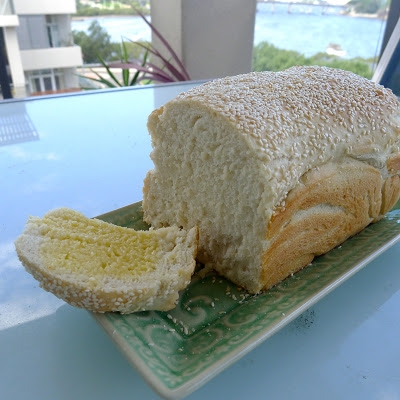Having recently made a focaccia, I thought I’d try my hand at a traditional white loaf of bread. There are fewer things greater than eating freshly baked warm bread, and if you’ve baked it yourself, it’s even greater. Why not try this simple recipe when you have a couple of hours on your hands?
Ingredients
- melted butter, for greasing and brushing
- 500g (3 1/3 cups) plain flour
- 2 tsp (7g/1 sachet) dried yeast
- 3 tsp salt
- 375mls (1 1/2 cups) lukewarm water
- extra water, for brushing
- 1 tsp poppy or sesame seeds, for sprinkling
Method
- Brush a 10 x 20cm (base measurement) loaf pan with the melted butter to lightly grease. Measure all your ingredients. Yeast plays an important role in bread-making. It ferments and grows when combined with “food” such as flour and/or sugar, and warmed. Carbon dioxide is produced and trapped in the dough as tiny air bubbles which make the bread rise during cooking and give it its characteristic texture.
- Salt is added to bread dough simply to add flavour.
- Place the plain flour, yeast and salt in a large bowl and mix throughly to combine. Make a well in the centre and add the water to the dry ingredients. The water needs to be lukewarm to activate the yeast and encourage it to grow. If the water is too hot, it can kill the yeast.
- Use a wooden spoon to stir until combined and then use your hands to bring the dough together in the bowl.
- Turn the dough onto a lightly floured surface and knead for 8-10 minutes or until smooth and elastic. Kneading distributes the yeast evenly through the dough and develops and strengthens the gluten in the flour which will form the framework of the bread. The best way to knead is to use the heel of your hand to push the dough away from you and then lift it with your fingertips and fold it over itself towards you. Turn the dough a quarter turn and repeat. You can tell when the dough has been kneaded enough by pressing your finger into the surface of the dough – if it springs back, it has been kneaded sufficiently. If the dough hasn’t been kneaded enough, the resulting bread will have a holey, crumbly texture and poor structure.
- Shape the dough into a ball. Brush a large bowl with the melted butter to grease. Place the dough into the bowl and turn it over to lightly coat the dough surface with the butter. This will stop the surface of the dough drying out as it stands, which can affect the rising process. Cover the bowl with plastic wrap or a damp tea towel and then place it in a warm, draught-free place to allow the dough to rise. A good place to stand it is on a wooden board on the door of the oven with the pilot light on, or in a sheltered, sunny spot. If the temperature is too high, it may kill the yeast, making the dough useless. The ideal temperature for rising bread dough is around 30°C.
- Leave the dough in this spot until it is double its size. This process is known as “proving” and the time it takes will depend on where you stand the bowl and on the warmth of you kitchen. The slower the rising, the more even and close the bread texture will be. However, if the dough rises too slowly, or too rapidly, the final bread will have a less even texture and an unpleasant yeasty flavour. This quantity of bread dough should take between 45-75 minutes to double in size. When the dough is ready, it will retain a finger imprint when lightly pressed. If left to rise for too long, the bread texture will be uneven and have large holes. If not left for long enough, it will have a heavy, dense texture.
- Once the dough has doubled in size. Punch it down in the centre with your fist. This step, known as “punching” or “knocking” down the dough, release excess carbon dioxide produced by the yeast during rising so the final bread won’t have a “yeasty” flavour.
- Turn the dough onto a lightly floured surface and knead again for 2-3 minutes or until smooth and elastic and returned to its original size.
- Preheat oven to 200°C.
- Either place all the dough in one ball and shape to fit the pan, or divide the dough into 2 equal portions and shape each into a smooth round. If the dough is unevenly divided and/or shaped unevenly, the final bread will be irregular in appearance. Place the portions of dough side by side in the greased loaf pan. Brush lightly with the melted butter. Stand the pan in a warm, draught-free place, as before, for about 30 minutes or until the dough has risen about 1cm about the top of the pan.
- Gently brush the loaf with a little water and then sprinkle with the poppy seeds. Bake in preheated oven for 30 minutes or until golden and cooked through. The best way to tell when the loaf of bread is cooked is to tap it on the base with your knuckle – if it sounds hollow, it is cooked.
- Turn the loaf immediately onto a wire rack and allow to cool. If left in the pan, the loaf will sweat and the crust will become soft.
- Once cool, store the loaf in a well-ventilated place at room temperature. This bread is best eaten on the day it is made. However, it makes great toast 1-2 days later. Make any stale leftovers into breadcrumbs and freeze in a sealed freezer bag to have on hand for later use.


